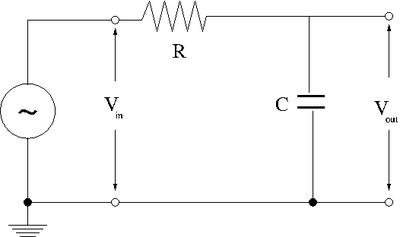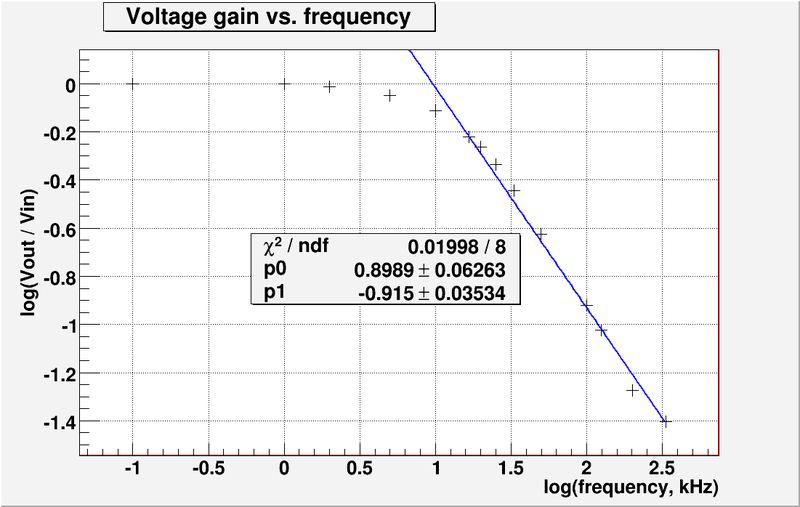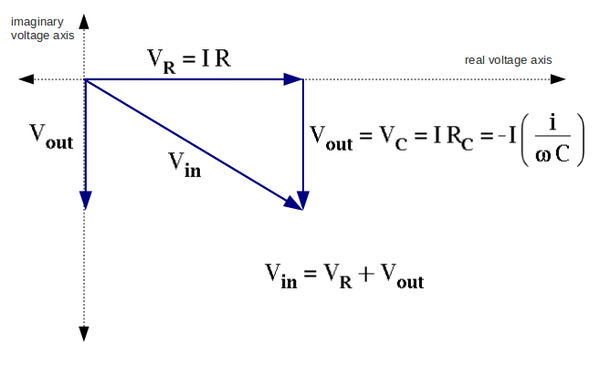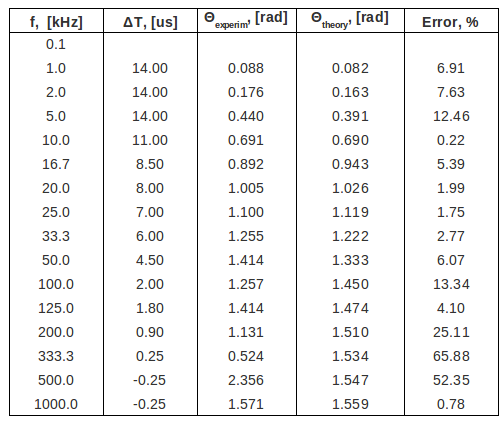Difference between revisions of "Lab 3 RS"
| Line 26: | Line 26: | ||
{| border="1" cellpadding="12" cellspacing="0" | {| border="1" cellpadding="12" cellspacing="0" | ||
|<math>\nu\ [\mbox{kHz}]</math> ||<math>V_{in}\ [V]</math> || <math>V_{out}\ [V]</math> || <math>\frac{V_{out}}{V_{in}}</math> | |<math>\nu\ [\mbox{kHz}]</math> ||<math>V_{in}\ [V]</math> || <math>V_{out}\ [V]</math> || <math>\frac{V_{out}}{V_{in}}</math> | ||
| − | |||
|- | |- | ||
| − | |0.1 ||5.0 ||5.0 ||1.0 | + | |0.1 ||5.0 ||5.0 ||1.0 |
|- | |- | ||
| − | |1.0 ||4.2 ||4.2 ||1.0 | + | |1.0 ||4.2 ||4.2 ||1.0 |
|- | |- | ||
| − | |2.0 ||3.2 ||3.1 ||0.97 | + | |2.0 ||3.2 ||3.1 ||0.97 |
|- | |- | ||
| − | |5.0 ||1.8 ||1.6 ||0.89 | + | |5.0 ||1.8 ||1.6 ||0.89 |
|- | |- | ||
| − | |10.0 ||1.14 ||0.88 ||0.77 | + | |10.0 ||1.14 ||0.88 ||0.77 |
|- | |- | ||
| − | |16.7 ||0.90 ||0.54 ||0.60 | + | |16.7 ||0.90 ||0.54 ||0.60 |
|- | |- | ||
| − | |20.0 ||0.88 ||0.48 ||0.54 | + | |20.0 ||0.88 ||0.48 ||0.54 |
|- | |- | ||
| − | |25.0 ||0.82 ||0.38 ||0.46 | + | |25.0 ||0.82 ||0.38 ||0.46 |
|- | |- | ||
| − | |33.3 ||0.78 ||0.28 ||0.36 | + | |33.3 ||0.78 ||0.28 ||0.36 |
|- | |- | ||
| − | |50.0 ||0.76 ||0.18 ||0.24 | + | |50.0 ||0.76 ||0.18 ||0.24 |
|- | |- | ||
| − | |100.0 ||0.75 ||0.09 ||0.12 | + | |100.0 ||0.75 ||0.09 ||0.12 |
|- | |- | ||
| − | |125.0 ||0.74 ||0.07 ||0.095 | + | |125.0 ||0.74 ||0.07 ||0.095 |
|- | |- | ||
| − | |200.0 ||0.75 ||0.04 ||0.053 | + | |200.0 ||0.75 ||0.04 ||0.053 |
|- | |- | ||
| − | |333.3 ||0.76 ||0.03 ||0.039 | + | |333.3 ||0.76 ||0.03 ||0.039 |
|- | |- | ||
| − | |200.0 ||0.76 ||0.03 ||0.039 | + | |200.0 ||0.76 ||0.03 ||0.039 |
|- | |- | ||
| − | |1000.0 ||0.78 ||0.06 ||0.077 | + | |1000.0 ||0.78 ||0.06 ||0.077 |
|} | |} | ||
Revision as of 02:43, 26 January 2011
- RC Low-pass filter
1-50 kHz filter (20 pnts)
1. Design a low-pass RC filter with a break point between 1-50 kHz. The break point is the frequency at which the filter starts to attenuate the AC signal. For a Low pass filter, AC signals with a frequency above 1-50 kHz will start to be attenuated (not passed)
- To design low-pass RC filter I had:
2. Now construct the circuit using a non-polar capacitor
3. Use a sinusoidal variable frequency oscillator to provide an input voltage to your filter
4. Measure the input and output voltages for at least 8 different frequencies which span the frequency range from 1 Hz to 1 MHz
| 0.1 | 5.0 | 5.0 | 1.0 |
| 1.0 | 4.2 | 4.2 | 1.0 |
| 2.0 | 3.2 | 3.1 | 0.97 |
| 5.0 | 1.8 | 1.6 | 0.89 |
| 10.0 | 1.14 | 0.88 | 0.77 |
| 16.7 | 0.90 | 0.54 | 0.60 |
| 20.0 | 0.88 | 0.48 | 0.54 |
| 25.0 | 0.82 | 0.38 | 0.46 |
| 33.3 | 0.78 | 0.28 | 0.36 |
| 50.0 | 0.76 | 0.18 | 0.24 |
| 100.0 | 0.75 | 0.09 | 0.12 |
| 125.0 | 0.74 | 0.07 | 0.095 |
| 200.0 | 0.75 | 0.04 | 0.053 |
| 333.3 | 0.76 | 0.03 | 0.039 |
| 200.0 | 0.76 | 0.03 | 0.039 |
| 1000.0 | 0.78 | 0.06 | 0.077 |
5. Graph the -vs-
phase shift (10 pnts)
- measure the phase shift between and as a function of frequency . Hint: you could use as an external trigger and measure the time until reaches a max on the scope .
See table above, columns #5 and #6.
Questions
1. Compare the theoretical and experimentally measured break frequencies. (5 pnts)
method 1. Using fitting line
- Theoretical break frequency: 12.1 kHz
- Experimentally measured break frequency: 9.59 kHz
Q: The above was read off the graph? Why not use fit results? A: The fit was made by using GIMP Image Editor. I do not have so much experience with ROOT. But I will try to do it. Thank you for comment. A1: The fit was done by ROOT
- The fit line equation from the plot above is .
- From intersection point of line with x-axis we find:
- The error is:
method 2. Using the -3 dB point
At the break point the voltage gain is down by 3 dB relative to the gain of unity at zero frequency. So the value of . Using this value I found from plot above . So . The error in this case is 4.1 %.
2. Calculate and expression for as a function of , , and . The Gain is defined as the ratio of to .(5 pnts)
We have:
Dividing second equation into first one we get the voltage gain:
And we are need the real part:
3. Sketch the phasor diagram for ,, , and . Put the current along the real voltage axis. (30 pnts)
4. Compare the theoretical and experimental value for the phase shift . (5 pnts)
The experimental phase shift is
The theoretical phase shift is



